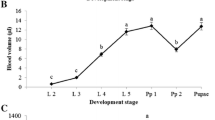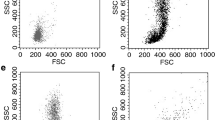Abstract
Hemocytes collected from larvae of Pseudoplusia includens (Lepidoptera: Noctuidae) were separated by centrifugation on Percoll cushions. The procedure resulted in 95% purity of plasmatocytes and greater than 99% purity of granular and spherule cells. Medium supplemented with chicken serum enhanced cell viability and promoted spreading of plasmatocytes. Cell-free plasma and medium preconditioned by plasmatocytes or granular cells stabilized cells in vitro and also accelerated spreading of plasmatocytes relative to medium supplemented with chicken serum. Oenocytoids were the only morphotype that exhibited endogenous phenoloxidase activity, while granular cells and plasmatocytes were the only cells that endocytosed fluorescent beads in vitro. Granular cells and plasmatocytes ingested fluorescently labelled beads, both in mixed populations of hemocytes and after separation. Plasmatocytes were the only morphotype that encapsulated large foreign targets in vitro following separation. Separated granular cells attached and spread on the surface of foreign targets but never formed a multilayered capsule.
Similar content being viewed by others
References
Anggraeni T, Ratcliffe NA (1991) Studies on cell-cell cooperation during phagocytosis by purified hemocyte populations of the wax moth, Galleria mellonella. J Insect Physiol 37:453–460
Ashida M, Ishizaki Y, Iwahana H (1983) Activation of pro-phenoloxidase by bacterial cell walls or β-1,3 glucans in plasma of the silkworm, Bombyx mori. Biochem Biophys Res Commun 113:562–568
Beck G, O'Brien RF, Habicht GS, Stillman DI, Cooper EL, Raftos DA (1993) Invertebrate cytokines III: inverstebrate interleukin-1-like molecules stimulate phagocytosis by tunicate and echinoderm cells. Cell Immunol 146:284–299
Bohn H (1977) Differential adhesion of the haemocytes of Leucophaea maderae (Blattaria) to a glass surface. J Insect Physiol 23:185–194
Chain BM, Anderson RS (1983) Inflammation in insects: the release of plasmatocyte depletion factor following interaction between bacteria and hemocytes. J Insect Physiol 29:1–4
Cherbas L (1973) The induction of an injury reaction in cultured hemocytes from saturniid pupae. J Insect Physiol 19:2011–2023
Coodin S, Caveney S (1992) Lipophorin inhibits the adhesion of cockroach (Periplaneta americana) haemocytes in vitro J Insect Physiol 38:853–862
Cook D, Stoltz DB, Pauley C (1985) Purification and preliminary characterization of insect spherulocytes. Insect Biochem 15:419–426
Davies HD, Hayes TK, Vinson SB (1988) Preliminary characterization and purification of in vitro encapsulation promoting factor: a peptide that mediates insect hemocyte adhesion. Dev Comp Immunol 12:241–252
Horohov DW, Dunn PE (1983) Phagocytosis and nodule formation by hemocytes of Manduca sexta larvae following injection of Pseudomonas aeruginosa. J Invertebr Pathol 41:203–213
Huxham IM, Lackie AM (1986) A simple visual method for assessing the activation and inhibition of phenoloxidase production by insect haemocytes in vitro. J Immunol Methods 94:271–277
Huxham IM, Lackie AM (1988) Behaviour in vitro of separated fractions of haemocytes of the locust Schistocerca gregaria. Cell Tissue Res 251:677–684
Johansson MW, Soderhall K (1988) Isolation and characterization of a cell adhesion factor from crayfish blood cells. J Cell Biol 106:1795–1803
Johansson MW, Soderhall K (1989) A cell adhesion factor from crayfish hemocytes has degranulating activity towards crayfish granular cells. Insect Biochem 19:183–190
Lackie AM (1988) Hemocyte behavior. Adv Insect Physiol 21:85–178
Mead GP, Ratcliffe NA, Renwrantz LR (1986) The separation of insect hemocyte types on Percoll gradients; methodology and problems. J Insect Physiol 32:167–177
Peake PW (1979) Isolation and characterization of the haemocytes of Calliphora vicina on density gradients of Ficoll. J Insect Physiol 25:795–803
Persson M, Vey A, Soderhall K (1987) Encapsulation of foreign particles in vitro by separated blood cells from crayfish, Astacus leptodactylus. Cell Tissue Res 247:409–418
Rantamaki J, Durrant H, Liang Z, Ratcliffe NA, Duvic B, Soderhall K (1991) Isolation of a 90 kDa protein from haemocytes of Balberus craniifer which has similar functional and immunological properties to the 76 kDa protein from crayfish haemocytes. J Insect Physiol 37:627–634
Ratcliffe NA, Gagen SJ (1977) Studies on the in vivo cellular reactions of insects: an ultrastructural analysis of nodule formation in Galleria mellonella. Tissue Cell 9:73–85
Ratner S, Vinson SB (1983) Encapsulation reactions in vitro by hemocytes of Heliothis virescens. J Insect Physiol 29:855–863
Rizki RM, Rizki TM (1990) Encapsulation of parasitoid eggs in phenoloxidase-deficient mutants of Drosophila melanogaster. J Insect Physiol 36:523–529
Rowley AF, Ratcliffe NA (1981) Insects. In: Ratcliffe NA, Rowley AF (eds) Invertebrate Blood Cells. Academic Press, New York, pp 471–490
Salt G (1970) The Cellular Defense Reactions of Insects. Cambridge University Press, Cambridge
Schmit AR, Ratcliffe NA (1977) The encapsulation of foreign tissue implants in Galleria mellonella larvae. J Insect Physiol 23:175–184
Soderhall K, Smith VJ (1983) Separation of hemocyte populations of Carcinus maenas and other marine decapods, and prophenoloxidase distribution. Dev Comp Immunol 7:229–239
Strand MR (1990) Characterization of larval development in Pseudoplusia includens (Lepidoptera: Noctuidae) Ann Entomol Soc Am 83:538–544
Strand MR, Noda T (1991) Alterations in the haemocytes of Pseudoplusia includens after parasitism by Microplitis demolitor. J Insect Physiol 37:839–850
Strand MR, Wong EA (1991) The growth and role of Microplitis demolitor teratocytes in parasitism of Pseudoplusia includens. J Insect Physiol 37:503–515
Strand MR, McKenzie DI, Grassl V, Dover BA, Aiken JM (1992) Persistence and expression of Microplitis demolitor polydnavirus in Pseudoplusia includens. J Gen Virol 73:1627–1635
Author information
Authors and Affiliations
Rights and permissions
About this article
Cite this article
Pech, L.L., Trudeau, D. & Strand, M.R. Separation and behavior in vitro of hemocytes from the moth, Pseudoplusia includens . Cell Tissue Res 277, 159–167 (1994). https://doi.org/10.1007/BF00303092
Received:
Accepted:
Issue Date:
DOI: https://doi.org/10.1007/BF00303092




